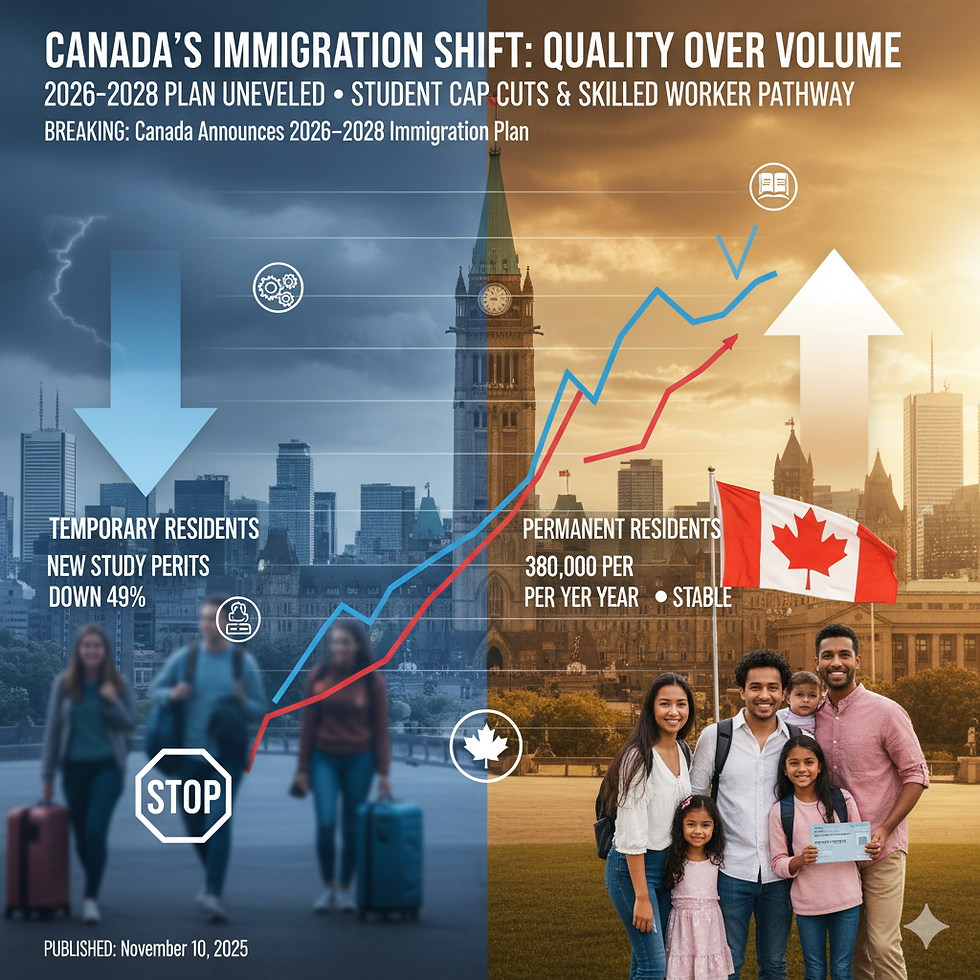Path From Visitor Visa to Study Permit
- Ansari Immigration

- Feb 21, 2024
- 3 min read
Table of Contents
Why Make the Switch?
The Ground Rules
Step-by-Step Guide to Switching from Visitor Visa to Study Permit in Canada
Tips for Success
Final Thoughts
If you're in Canada, soaking up the sights and sounds as a visitor, and suddenly find yourself dreaming about turning those temporary vistas into a classroom view, you're in the right place. Transitioning from a visitor visa to a study permit in Canada might sound like navigating through a maze, but with the right info, it's more like following a well-marked trail. Let's break it down together, shall we?
Why Make the Switch?
First off, why consider studying in Canada? Well, besides the stunning landscapes and the syrup, Canada is renowned for its world-class education system, diverse culture, and warm welcome to international students. It's a place where you can grow academically, personally, and professionally. Canadian universities and colleges are recognized globally for their high academic standards and emphasis on research in various fields. So, if you're here and you've got that study bug, why not dive in?
The Ground Rules
Before we get into the "how," let's talk about the "can you?" Part of this journey involves understanding the eligibility criteria. Generally, to switch from a visitor visa to a study permit within Canada, you need to:
Have a valid visitor status in Canada, and you must maintain that status throughout the process.
Get accepted by a Designated Learning Institution (DLI) that's approved by the government to host international students.
Apply before your current visitor status expires, or you might have to leave Canada to apply from abroad.

Step-by-Step Guide to Switching from Visitor Visa to Study Permit in Canada
1. Choose Your Program and School Wisely
Start by picking a program that lights a fire in your heart and aligns with your future goals. Canada offers a wide range of programs in areas like engineering, business, health sciences, and humanities. Make sure the institution is a DLI, as only DLIs can host international students on study permits.
2. Get Your Acceptance Letter
Once you've applied and been accepted, you'll receive an acceptance letter. This document is golden; you'll need it for your study permit application.
3. Check Your Eligibility for an In-Canada Application
Not everyone on a visitor visa can apply for a study permit from within Canada. Usually, you can if you're in a specific category, like a family member of someone with a study or work permit, or if you've completed a short-term course necessary for your acceptance into a longer program. If you don't fit these scenarios, you might need to apply from outside Canada.
4. Prepare Your Application
Gathering your documents is like packing for a hike – everything needs to be in order. Besides your acceptance letter, you'll need proof of financial support, identity documents, and a letter explaining why you want to study in Canada. Ensure you also include your study plan, outlining how the program aligns with your career goals.
5. Apply Online
With your documents in hand, it's time to apply online through the Immigration, Refugees and Citizenship Canada (IRCC) website. Remember, timing is crucial. Don't let your visitor status expire while you're waiting for your study permit.
6. Biometrics and Interview
After applying, you might be asked to provide biometrics or attend an interview. It's just another step on the path, so no stress needed.
7. Wait for the Decision
Patience is key here. The processing time can vary, so use this period to explore more of Canada or start preparing for your studies.
8. Extend Your Stay as a Visitor, If Needed
If your visitor status is close to expiring but your study permit hasn't been approved yet, you may need to apply to extend your stay as a visitor. This ensures you remain legally in Canada while your application is being processed.
Tips for Success
Research Extensively: Spend time researching various programs and institutions to find the best fit for your educational and career goals.
Understand the Costs: Be aware of the tuition fees and living expenses in Canada. Plan your finances accordingly to ensure you can support yourself during your studies.
Engage with Communities: Join forums or social media groups of international students in Canada. These communities can provide valuable insights and support throughout your application process and studies.
Final Thoughts
Transitioning from a visitor to a student in Canada is an exciting journey, filled with paperwork, yes, but also the promise of new academic adventures and opportunities. Keep your documents organized, follow the steps carefully, and you'll navigate this path with ease. Canada's education landscape is rich and inviting, and it's waiting for you to take that leap. So, why wait? Dive into your Canadian study adventure today!
Remember, each journey is unique, and while this guide aims to simplify the process, always check the latest guidelines from IRCC to ensure you have the most current information. Happy studying!




Comments